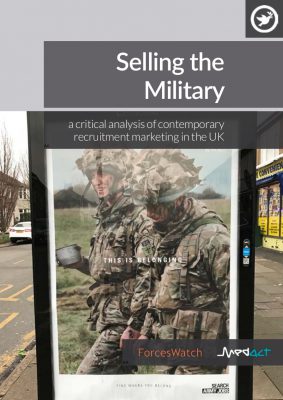Army dreaming

At the risk of becoming repetitive, the Army have once again launched a new-year advertising campaign with a ‘controversial’ edge and much media coverage.
A narrative advert forms the centrepiece of the campaign, with additional shorter ads showing moments of Army life, and a series of eye-catching posters. This is only the latest of the expensive, highly stratified and sophisticated marketing campaigns that the armed forces regularly put out. They use extensive research and top ‘creative’ companies to target key audiences, not only to enlist new recruits but also to generate wider social debate and public awareness about the military. Karmarama, the agency behind the Army’s marketing in recent years, talks of a strategy to create a ‘shift in perceptions’ about an Army career but also to result in ‘people reappraising the Army generally’.(1)
Pushing out a provocative campaign on a slow news day to coincide with the January blues and new year’s resolutions, helps to gain traction. The campaign particularly targets audiences from low-income households and areas with higher levels of deprivation. It utilises a wealth of broadcast, social media and other channels and blurs the distinction between entertainment and advertising, an effective way to create a positive perception of life in the forces.
The campaign particularly targets audiences from low-income households and areas with higher levels of deprivation.
Selling a quick fix
The main TV advert makes the bold statement that ‘Army confidence lasts a lifetime’. It depicts a young soldier walking as part of a unit strung out across a barren landscape. He is momentarily plagued by figures tempting him with various hollow confidence boosters, such as nights out and consumer products, but pulls himself together and receives a reassuring friendly pat on the shoulder from a fellow soldier.
The accompanying poster series is designed to contrast the ‘challenge the promises of confidence that surround us in the modern world’ with the ‘longer lasting confidence that can be found in the Army’. In reality, the posters act just as provocations and attention-grabbers.
The emphasis is very much on style over substance and, as a result, does not indicate how #ArmyConfidence may be achieved. However, the simple and buyable catchphrase, the emotive narrative form and high-end Hollywood-style production values will no doubt spark much interest. Last year’s Army marketing was highly successful in increasing applications although the rate for translating these into actual recruits has in the past been very low (2).
The ‘military is better’ fantasy
The new #ArmyConfidence tag is the latest incarnation of the concept that is central to almost all military recruitment adverts – that an armed forces career offers an opportunity to become the person you want to be, to ‘be the best’. And, not only will you become ‘a better you’ than you could be in civilian life, but a military career is a sure way of fixing social problems faced by young people.
The new Army TV advert fulfils this ‘military is better’ narrative by visual comparison between shallow civilian and military caricatures. This comparison is not only almost laughably simplistic but it is also highly problematic. Neither the one dimensional depiction of civilian options available to young people, nor the proposition that a career in the forces will necessarily lead to self development and fulfilment, hold up to even the most basic scrutiny.
The new Army TV advert fulfils this ‘military is better’ narrative by visual comparison between shallow civilian and military caricatures.
It is disconcerting that while Karmarama calls itself ‘the UK’s most progressive creative agency’ it seems happy to make rather false comparisons and sweeping promises about a career that can cause serious harm. The company states that ‘the Army helps recruits build a unique lifelong confidence’, but that is not the same as demonstrating how. It focuses only on the most shallow confidence boosters such as make-up and social media as if civilians have nothing more substantial in their lives. Referring to statistics about the desire of ‘Gen-Z’ for greater confidence also does not do the work of showing how and if the Army are, in fact, a better place to gain that confidence than other jobs and ways of living.
Reinforcing stereotypes
Last year’s Army marketing hit a controversial note by suggesting that certain personality ‘types’ – ‘snowflakes’, ‘millennials’, ‘gamers’ – may be interested in, and have something to offer, the Army. This year’s stereotypes – the gym-obsessed muscle man, the drunk girl on a night out, the guy flogging the latest trainers – are cruder and more exaggerated, and reinforce class, gender and race stereotypes. These look like caricatures from a bad dream or a very bad film; they seem to have more to do with categorising and demonising other people than with identifying the potential within them. It would not be the first time that young people have been stereotyped and criticised by the Army for not being the kind of people that want to enlist.
These look like caricatures from a bad dream or a very bad film; they seem to have more to do with categorising and demonising other people than with identifying the potential within them.
The young soldier at the centre of the advert is male and white, as most of the British Army still are, despite efforts by all the forces to increase diversity by attracting more women and BAME recruits. However, wider audiences could well be put off by these one-dimensional and judgmental depictions.
That ‘racism is prevalent’ in the armed forces was confirmed yet again in a recent BBC interview with the Service Complaints Ombudsman and research by the Guardian. Sexual harassment is also a significant problem in the UK military. Using simplistic stereotypes to convey marketing messaging will certainly not contribute to a culture of diversity.
Myth and reality
The ‘crisis’ in military recruitment – a result of long-term social and demographic changes as much as recent misjudgement by the military – has been widely discussed. However, retention problems may be even greater; in recent years more people are leaving the Army than joining it.
Our research details how, far from being a guarantee of making the most of oneself, there is ample statistical and anecdotal evidence to show that many do not fare well in the military, many leave early on, and many of those still serving are not satisfied with the job. Marketing based on wishful thinking may attract new recruits but it can not make the realities of a military career more palatable.
Army dreamers
Of course advertising is all about selling a dream, and dreaming of a better life in the Army, far away from home, is not a new thing. The vision of a big exciting world where you can find your place and your skills will develop and be respected is particularly powerful for young people who are still figuring out how and where they can belong.
Armed forces marketing goes direct to the heart of young people’s needs with its emotion-driven and diversity-friendly straplines. Belonging, confidence, acceptance are key vulnerability issues for adolescents (young people aged 16-24, which form the target audience for military marketing). Furthermore, such vulnerabilities are more acute for young people who have experienced difficulties in childhood. Adolescents can also be particularly susceptible to marketing messages and to being attracted to risk-taking behaviour.(3)
Armed forces marketing leverages the power of these emotional hooks as successfully as any blockbuster or music video. In the process, they also obscure the fundamental nature of the military and what it asks of those that are part of it. Information that should inform such an important life choice – about risks and legal obligations – is absent from materials available to potential recruits and their parents.
Armed forces marketing leverages the power of these emotional hooks as successfully as any blockbuster or music video.
Moving beyond marketing
 As we argue in our Selling the Military report, as a society we should not be judging these recruitment campaigns on metrics relating to the number of new recruits attracted by them. Instead, we should be utilising ethical standards that prioritise informing recruits about all aspects of a military career rather than promoting just some. We also need to raise the age of recruitment so that recruits who are vulnerable as a result of their young age, must wait until they are 18 to make a decision that will be life-changing. We need to give due regard to research on the impact of military service, especially for the very young, and those who have experienced prior adversity. Wider concerns around marketing to adolescents, should also be considered.
As we argue in our Selling the Military report, as a society we should not be judging these recruitment campaigns on metrics relating to the number of new recruits attracted by them. Instead, we should be utilising ethical standards that prioritise informing recruits about all aspects of a military career rather than promoting just some. We also need to raise the age of recruitment so that recruits who are vulnerable as a result of their young age, must wait until they are 18 to make a decision that will be life-changing. We need to give due regard to research on the impact of military service, especially for the very young, and those who have experienced prior adversity. Wider concerns around marketing to adolescents, should also be considered.
Many veterans have voiced their own experience of not finding belonging and self-fulfilment as a result of military service. In response to the current Army marketing, two parents of young soldiers who were both killed aged 18 in Afghanistan have criticised the adverts for claiming that the Army will boost confidence if it is lacking. One said that young people were “being sold a lie” and that, for someone lacking in confidence, being in the Army “could ultimately break them.” In a welcome bid for media balance, a BBC Newsbeat article explored some of the downsides of an armed forces career: a former soldier complained that he left the Army because the job was boring, the money terrible, the accommodation awful and food ‘the worst’.
He said that the Army “can become a breeding ground for bad egos. And if your face didn’t fit your life was hell.” The Army still have quite a job to do to really deliver on its inclusive dream of belonging.
1. Marketing Week, 11/04/2019, How the British Army’s ‘Snowflake’ ads led to a ‘shift in perceptions and attitudes’,
2. ForcesWatch and Medact, 2019, Selling the military: A critical analysis of contemporary recruitment marketing in the UK, page 18.
3. Ibid, page 19.
See more: recruitment, recruitment age, advertising
Like what you read?
> Sign up for our newsletter or blog notifications
> Support our work – from just £2 a month









